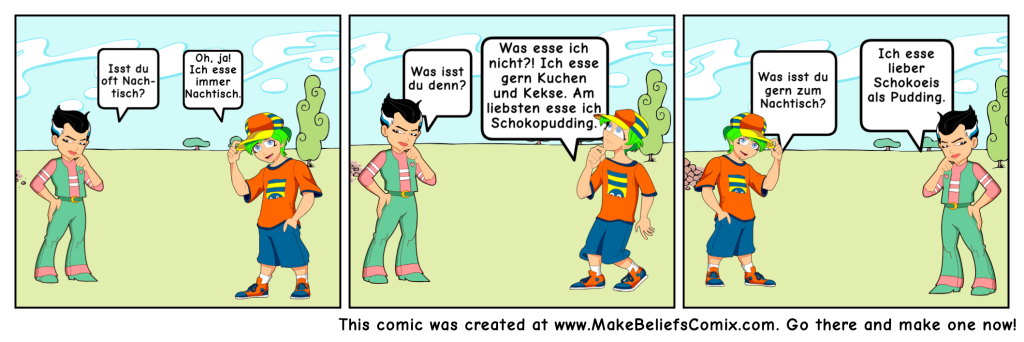6.9 Um den Pudding gehen

Guten Tag!
Zum Aufwärmen machen wir unseren Tagesminiplausch und eine Wiederholung.
Wiederholung
In the previous lesson, you learned how to talk more about the warme Mahlzeit by talking about the frequency with which you consume some typical foods, asking others about their preferences, and talking about your preferences. Let’s review what you have learned.
Wann und wie oft isst du warm? Was isst du gerne? Was isst du am liebsten? Answer the questions in your written journal. Then record in your audio journal.
Lektionsüberblick
At the end of a large meal, you may want to go for a walk (which is called a Verdauungsspaziergang = a digestive walk). If you are in Northern Germany, someone may prompt such a walk by saying “Laß uns um den Pudding gehen” (=to walk around the pudding). This lesson will focus on the pudding you eat for Nachtisch (dessert), which is generally served after the warme Mahlzeit. In the end, you will be able to 1) talk about how often you have Nachtisch (dessert), 2) ask others about their Nachtisch preferences, and 3) talk about your Nachtisch preferences.
Was weißt du schon?
| Noch nicht start klar?
Du kannst immer auf die gleiche 1010-Lektion zurückgreifen! |
Not confident about starting this lesson?
You can always review the same Lektion from 1010. |
1) Wie oft isst du Nachtisch?
Do you remember what words you need to talk about how often you do something? Let’s check!
Now let’s look at the different ways we can talk about how often we eat dessert:
Ich esse immer etwas zum Nachtisch.
Ich esse manchmal Nachtisch.
Ich esse keinen Nachtisch.
Jetzt bist du dran!
Österreich im Blickpunkt

Der Kaiserschmarrn ist eine verfeinerte Form des Schmarrns, der in seiner Zubereitung dem Palatschinkenteig (Pfannkuchen) ähnelt. Schmarrn bezeichnet eine Gerichtszubereitung, bei der die Ausgangsmasse grob in kleine Stücke zerteilt und durchgemischt wird. Kaiserschmarrn zählt zu den bekanntesten Süßspeisen der österreichischen Küche. Er wird oft mit Zwetschkenröster serviert. Der Name leitet sich von Kaiser Franz Joseph I. ab. Die Süßspeise wurde erstmals 1854 der österreichischen Kaiserin Elisabeth serviert.
Kaiserschmarrn is similar to pancake in its preparation and is a refined form of the Schmarrn. Schmarrn is a food preparation, in which the dough is cut into large pieces and mixed. Kaiserschmarrn is one of the most well-known Austrian desserts. It is often served with a kind of plum compote. It is named after the Austrian emperor (Kaiser) Franz Joseph I. The dessert was first served to the Austrian Empress Elisabeth in 1854.
2) Was isst du zum Nachtisch?
If someone eats dessert with any regularity (anything more than never), then it can make sense to ask what they eat for dessert. Let’s look at how such a conversation might happen.
 |
You can always ask “Was isst du zum Nachtisch?” but if you’ve already asked “Isst du Nachtisch?” it can sound a bit strange to repeat the words for dessert. You can also ask “Was isst du gern?”
Jetzt bist du dran!
3) Ich esse lieber … zum Nachtisch.
To talk about our dessert preferences, we need to remember the various words for kinds of desserts and the words for comparison and preference. Let’s first review the words for desserts:
Now let’s look at talking about dessert preferences.
 |
Now let’s practice.
Jetzt bist du dran!
Zum Schluß

*As you conclude this lesson, don’t forget to check Canvas!*

Media attributions
- Kaiserschmarrn and Schmarrn text adapted from Wikipedia, licensed under a CC BY-SA 4.0 International License.

